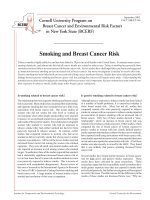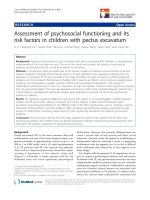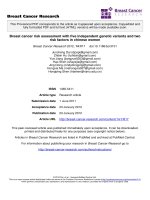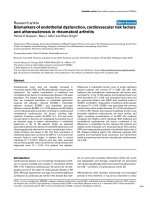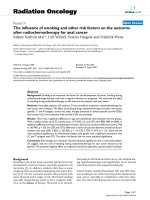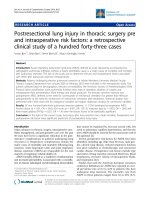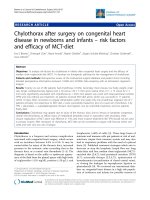Prevalence of obesity and associated risk factors in chinese pre school children aged 6 to 72 months old in singapore 1
Bạn đang xem bản rút gọn của tài liệu. Xem và tải ngay bản đầy đủ của tài liệu tại đây (169.46 KB, 33 trang )
PREVALENCE OF OBESITY AND ASSOCIATED RISK
FACTORS IN CHINESE PRE-SCHOOL CHILDREN
AGED 6 TO 72 MONTHS OLD IN SINGAPORE
CHAPTER 1
1. LITERATURE REVIEW
1.1
Introduction
Obesity is a condition in which there is an abnormal excessive
accumulation of adipose tissue, causing negative effects to health.1,2 Obesity is
primarily due to an imbalance between energy intake and energy expenditure,
usually resulting from increased food intake and/or decreased physical activity. 3, 4
Although the prevalence of obesity has been steadily increasing
worldwide for many years, the steep rise in the number of obese children and
adolescents since 1980s5, 6 has elevated obesity to epidemic status, putting it at the
top of the WHO’s Public Health agenda.7
1.1.1 Aetiology of Obesity
Multiple factors such as genetics8-13 and behavioral factors14-17 may
contribute to obesity. There are several reports of gene mutations associated with
1
body weight regulation. Variations in the fat mass and obesity-associated gene
(FTO) show a strong and highly significant correlation with obesity but the
mechanisms remains unclear.8-10 Moreover, genome-wide association studies
showed that a variation in the PFKP gene involved in glycolysis is also strongly
associated with obesity.8 Leptin and leptin receptor genes are two well-known
factors that play a role in obesity. Polymorphism in either the leptin gene or the
leptin receptor gene can produce inactive leptin or inefficient leptin action (leptin
receptor dysfunction), and increased neuropeptide Y level, resulting in overweight
or obesity.11-13
In the past three decades, overweight and obesity have become primary
problems in Western countries. Many other countries have now adopted the
Western culture and behavior and have changed their food consumption behavior
because of increased availability and accessibility of fast foods and manufactured
foods which are high in fat and sugar. For recreation, adults spend more time
watching television, playing video games, browsing the web and other internetrelated activities. A sedentary life style combined with physical inactivity and
unhealthy foods explain the growing epidemic of obesity for both young and old
people.1, 14-17
1.1.2 Consequences of obesity
Obesity can cause weight-related problems and even mortality.1,18
Complications of childhood obesity include high blood pressure,19,20 high
2
cholesterol,20 diabetes,21 and in later years, early heart diseases.22,23 Other comorbidities associated with childhood obesity are orthopedic problems, skin
fungal infections, acanthosis nigracans, hepatic steatosis, pseudotumor cerebri and
psycho-social consequences.24-26 Moreover, overweight children are more likely
to remain overweight as adults.18,27,28
One of the cardiovascular risk factors of obesity is hyperlipidemia.26 The
prominent sign of hyperlipidemia is central fat distribution and the symptoms are
elevated serum low-density lipoprotein cholesterol (LDL) and triglycerides (TG)
but lowered high-density lipoprotein cholesterol (HDL).20,
25
The mechanism is
the same as in adults. Obese children possess increased free fatty acids in their
blood circulation resulting from lipolysis and hyperinsulinemia due to increased
intake of food.25 Free fatty acids stimulate the hepatic synthesis of LDL and TG
which can lead to fat deposition and obesity.25 Non-insulin dependent diabetes
mellitus is another complication. Increased body fat mass cause increased basal
insulin secretion and impaired glucose tolerance.25, 29 A possible mechanism for
high blood pressure in obese individuals is hyperinsulinemia. Activation of the
rennin-angiotensin-aldosterone system and reduction of renal sodium excretion by
hyperinsulinemia are explanations for high blood pressure in obese individuals.25,
29
Hypertension is also a risk factor for cardiovascular diseases. 26
Moreover, majority of obese youth and adults experience psycho-social
consequences of obesity. For example, low self-esteem and being targeted as a
victim for bullying in schools are the social outcomes of obesity for youth.30 For
3
adults, obesity results in weight bias and discrimination in employment,31
psychological problems,32 not having a relationship with opposite sex in women
and poor educational achievement in men.33
1.1.3 Assessments of Obesity
Overweight and obesity should ideally be defined by the amount of body
fat. However, the standard anthropometric measurements available to assess body
fat are not ideal. Better measurement techniques are complex and costly, and
impractical for epidemiological research and clinical assessment.34
In clinical settings, the skin fold measurement (the measurement of
subcutaneous layer of fat) is accepted as a reasonable correlate of body fat.34-37 In
combination with Body Mass Index-for-age to estimate adiposity in children,
skinfold measurement can improve the estimation of body fatness except in
overweight (≥95th percentile) children and adolescents.38,39 However, due to
differences between observers, measurement errors are common, resulting in poor
reliability and reproducibility.35-37
Thus, the common, inexpensive and practical method of obesity
measurement, Body Mass Index (BMI), has been recommended, based on the
high reliability of measurements of height and weight.34,35,40 BMI is calculated as
the child’s weight in kilograms divided by his/her height in meters, squared. The
limitation of this measurement is that it cannot accurately distinguish between
4
adiposity and muscularity.1,36 BMI for children also changes with age, so the BMI
standard deviation scores and percentiles are more useful when tracking children
and their progress. Similar to BMI, another practical method which has already
been widely used for screening of overweight and obesity in preschool children is
weight-for-height measurement. 40,41
In research settings, one of the commonly used methods include dual
energy X-ray absorptiometry (DEXA) which can measure bone mass, lean body
mass and fat mass separately and the accurate percentage of body fat can be
calculated.34-36 Based on a similar theory, there is a method of under-water
weighing (densitometry).35 Both methods require sophisticated apparatus and
complex techniques.34 Besides DEXA, other accurate, rapid, non-invasive
methods include the bioelectrical impedance analysis, computed tomography
(CT/CAT scan) and magnetic resonance imaging (MRI/NMR). 3, 34
1.1.4 Definition of Obesity
For adults, obesity is defined as a BMI ≥30kg/m² and overweight as a
BMI between 25kg/m² to 29.99kg/m².1,
40
For children, although the BMI
calculation is the same as for adults, obesity is determined based on BMI-for-age
curves with percentile units, or weight-for-height curves.
In addition, definition of obesity and overweight for children varies
between countries.2 Two well known and commonly used definitions are from the
5
United States Centre for Disease Control (CDC) and the International Obesity
Task Force (IOTF).
Based on nationally representative data in the United States, the CDC
defines a BMI above the 95th percentile for age as “overweight” and above the
85th percentile for age as “at-risk-for-overweight”.42 But these cut off points are
mainly for the United States and are arbitrary. They are generally not considered
appropriate for use with other populations/countries.
The IOTF attempted to define obesity cut-off points which can be
accepted internationally for the purpose of a unified international definition to
facilitate epidemiological research and comparison across different populations.
The IOTF defined percentile curves for overweight and obesity which intersect
the adult cut-off points of a BMI of 25kg/m² and 30kg/m2 at age 18 years,
respectively.43 The cut-off points proposed by the IOTF are age and sex specific,
and are based on data from six countries: the United States, Great Britain, Hong
Kong, the Netherlands, Brazil and Singapore.43
Although these cut-off points are recommended for international
comparisons, the cut-offs are mainly representative of Western countries and less
reflective of data from African and Asian countries.44 Moreover, data for
Singapore children aged 2–6 years are not available for that dataset.43 Therefore,
Singapore data was not included in the derivation of the IOTF cut-off points for
children aged 2–6 years.43 Thus, the IOTF BMI cut-off points may not be
applicable to preschool children in Singapore.
6
BMI and body fat percentage vary across different ethnic groups.45-48
Asians have a high body fat percentage with low BMI compared to Caucasians,
due to differences in body composition.45,49,50 The WHO expert consultation on
BMI in Asian population, held in Singapore, 2002, concluded that the current
WHO BMI cut-off points may underestimate the prevalence of overweight and
obesity for Asian populations based on adverse health outcomes for Asian
populations, which occur at lower BMIs. Asian countries were encouraged to
make decisions about the definitions of increased risk for their population and
WHO BMI cut-off points were used for international comparisons.45
1.1.5 Ethnic Difference
In the United States, Hispanic children are more obese than non-Hispanic
black and non-Hispanic white children.26, 27, 51 Asians and Africans, except those
from the Middle East and North Africa, have a lower prevalence of overweight
and obesity than Western ethnic groups.52 The difference in prevalence of
overweight and obesity among ethnicities may be due, in part, to differences in
central fatness and muscularity, resulting in differences in body fat percentage and
BMI.53 Generally, differences may be attributed to different patterns of food
consumption, attitudes towards food or genetic differences.
7
1.2
Prevalence of obesity across countries
1.2.1 Methodology of literature review
Using the PubMed database, I searched “prevalence AND (overweight OR
obesity) AND preschool children” and total of 2,218 articles were found. I
narrowed down the topic search to “prevalence of overweight and obesity study in
preschool children” and found 865 articles. After that, I chose the titles related to
the topics and found 63 articles. Next, I read through all the abstracts of these and
retrieved 8 of the best articles. There were in total of 1,287 articles in the Scopus
database and I followed the same method of literature review in PubMed database
and finally, found 1 new good article from the Scopus database.
1.2.2 Asian countries
A population-based study of the prevalence of obesity in preschool
children was conducted in China in 2000. Liu et al. (2007)54 found a prevalence of
7.4% of overweight and obesity in a large population of 262,738 preschool
children aged 3.5–6.4 years. The study areas were the northern rural, southern
rural and southern urban areas. Children who were born between 1993 and 1996
to a mother residing in one of these areas for at least one year were included. The
response rate was not mentioned. The study used international age- and genderspecific BMI cut-off points to compare with other countries and found that the
8
prevalence of obesity is similar to that of Great Britain or the United States in the
1980s or earlier.
In 2000, according to data obtained from the National Nutritional Survey,
de Onis and Blossner analysed 2,854,677 children from 94 developing countries,
and found that the prevalence of obesity in <5 years old children was 3.3%.55
Latin America and the Caribbean had the highest prevalence of 4.4%, with 3.9%
in Africa, and Asia contributed 2.9% which was the third highest prevalence. But
in absolute numbers, 60% of overweight children from developing countries lived
in Asia. This study analysed only nationally representative surveys from various
developing countries which were conducted between 1985 and 1998. But there
were no standardized equipment or measurement techniques between countries.
In 2008, Ibrahim et al. conducted a prevalence study of obesity in
preschool children aged 3–6 years (n=1,695) in Jordan.56 The children were
randomly selected from paying nurseries of both rural and urban areas which
constituted 2.1% of the total paying nurseries in Jordan. The study reported the
prevalence of obesity as 20.8% in boys and 19.1% in girls and overweight was
3.8% in boys and 7.2% in girls, by using the reference of Cole et al. This study
showed that the prevalence of obesity was higher than overweight in the Jordan
preschool children. Moreover, the mean BMI of children participating in this
study was equivalent to the 75th percentile of the CDC/WHO reference value.
Although the author mentioned that the ratio of children attending these paying
nurseries to those attending governmental free nurseries equalled 15:1, the study
9
did not include children who did not go to any nursery or children who were
attending the governmental free nurseries. Therefore, this study is not
representative.
1.2.3 Non-Asian countries
Ogden et al. (2010) (n=3,281), reported that in the United States, 10.4% of
children aged 2 to 5 years were at or above the 95th percentile, and 21.2% of those
were at or above 85th percentile, using the 2000 CDC sex-specific BMI for age
growth charts.57 This study derived data from the National Health and Nutrition
Examination Survey (NHANES). The survey was a nationally representative
survey and aimed to evaluate the health and nutritional status of children and
adults.58 The response rate for NHANES 2007-2008 was 82.1%. Overall, among
2 to 5 years old children, there was no statistically significant difference between
genders at these BMI for age percentiles.
In Canadian preschool children between 3 and 5 years of age, the
prevalence of overweight or obesity was 25.6% (Canning et al.) (2004).59 A total
of 4,161 children were selected from the population born in 1997 and
subsequently enrolled in the preschool health check program in 2002. It was the
first province-wide report in Canada with a good response rate of 73–84%. The
author also reported that there were no significant differences between gender and
age groups.
10
Kalies et al., in 2002, reported that the prevalence of obesity between 5–6
years old children was 2.8% in Bavaria, the largest and the second most populated
state of Germany.60 This study was based on a huge number of children (126,083)
from the school entry health examination and had a very high response rate of
97.1%. In comparison with countries with the same definition of obesity, the
prevalence of obesity in Germany was lower than that in the United States and
Australia.60
There were two studies in Chile: a study in 2008 of children aged 2 to 5
years (n=25,013) by Stanojevic et al., with a prevalence of 16.4%61 and one in
2002 by Kain et al., with a prevalence of 14.7% in boys and 15.8% in girls in a
group of 6 years old children (n=199,444).62 These two studies did not mention
the response rates. In the 2008 study, the sample selection was taken from low
and middle income families and children who attended the Junta Nacional de
Jardines Infantiles (JUNJI) program whereas in the second study, the samples
were of the children who entered the first grade. So, both studies might not be
representative of the Chilean population.61,62 The study in 2002 described that the
prevalence had increased between
1987 and 2000 whereas the 2008 study
showed that the prevalence remained constant during the previous nine years.
In an Italian study (n=2,150) conducted by Maffeis et al. (2006), 8% of
children aged 2–6 years were obese.63 Although it was the first study that
provided international comparisons by analysing the data with three different cutoff points, it was not population based due to random selection of children from
11
the registers of kindergartens located in both urban and rural areas. But this study
showed a good response rate of 89.6%. The authors also showed that the
prevalence in Italian preschool children was as high as in the United States.
1.2.4 Limitations to comparisons between countries
However, these studies could not be compared because they were
conducted in different ways. First, most of the studies did not mention the
response rates. Therefore, we do not know if there is any non-response bias.
Second, non-population-based studies may not represent the population at large,
and cannot be compared with population-based studies. Third, the sampling
techniques were different among these studies. Moreover, some studies used the
existing data from other programmes together with new data. When height and
weight were measured in these studies, the equipment and measurement
techniques used were not the same and not standardized from one study to
another. The last limitation was that different references were used to define
obesity in each study and some studies did not describe the overall prevalence but
they described it according to gender. Therefore, all the studies were not
comparable, but comparison between groups with the same cut-off points could
be summarized.
12
1.2.5 Summary of the studies, comparing with the same definition
There were two studies using both CDC and IOTF definitions to compare
the prevalence of obesity with other countries. One study was from Chile (2002)62
and the other was from Italy (2006)63. In both studies, the prevalence of obesity
with the CDC definition (14.7% in boys and 15.8% in girls in the Chilean study
and 16% in the Italian study) was higher than that the IOTF definition (7.2% in
boys and 7.5% in girls in the Chilean study and 8% in the Italian study).
The studies using the CDC definition were from Chile (2008)61, the Italian
study mentioned above63, and one from the United States57. A comparison of
these studies showed that Chile had the highest prevalence (16.35%)61 followed
by the studies from Italy (16.0%)63 and the United States (10.4%)57. Although
there were six studies using the International Obesity Task Force (IOTF) criteria
for the definition of obesity, only three studies compared the prevalence of
obesity because the other three studies described according to gender. Among the
three studies mentioning the prevalence, the same study from Italy had the highest
prevalence of obesity (8%)63, followed by China (7.4%)54, and Germany had the
lowest prevalence (2.8%)60.
Another three studies reported the prevalence by gender; the highest
prevalence of 20.8% (boys) and 19.1% (girls) were found in Jordan.56 The second
highest were from the study of Canada with 7.8% (boys) and 8.2% (girls)59,
followed by 7.2% (boys) and 7.5% (girls) from Chile62.
13
For gender, two studies from China (2000) and Chile (2008) showed that
the prevalence of overweight or obesity for girls was higher than for boys.54,61
However, the study from Jordan showed that overweight was more common in
girls than in boys but obesity was more common in boys than in girls.56 Moreover,
no significant difference in gender was seen in the United States57 and Canadian
study.59 However, the studies from Germany60 and Chile62 showed that although
there were no significant difference in obesity, the prevalence of overweight was
higher in girls than boys.
There were also three studies describing prevalence by the age group.
Among the three studies, the studies from Canada (2004)59 reported that the
prevalence by age was not significantly different. However, the gradual increment
of obesity prevalence was seen in the study from Chile (2008)61 and the reverse
trend was seen in the study from China (2000)54.
14
Table 1. Prevalence of obesity in preschool children across countries
Asian Countries
Study
Country
Sampling
frame
Age
N
Response Rate
Methodology
Cut-off points
Prevalence
Obesity/
Overweight
Liu J-M (2000)
China
56 counties of
both rural and
urban
3.5-6.4
year
262,738
Not mentioned
Standardized
measurement
by locally trained
health workers
Obesity-Centiles
corresponding to
BMI 30kg/m2
Overweight/
At-risk-for
overweight
7.4%
-
OverweightWeight for
height >2 SDs
from the
NCHS/WHO
international
reference median
value
3.3% ( all
developing
countries)
-
ObesityBMI >97th
percentile
20.8% (boys)
19.1% (girls)
OverweightCentiles
corresponding to
BMI 25kg/m2
De Onis M &
Blossner M
(2000)
Ibrahim A.I.
(2008)
Developing
countries (94
countries)
Jordan
Data obtained
from National
Nutritional
Surveys from
94 countries
< 5 year
Children from
randomly
selected
nurseries
3-6 year
2854,677
1695
Not mentioned
Not mentioned
Standard procedure
of measurement
Standard procedure
by five well trained
anthropometrists
2.9%(Asia)
3.9%(Africa)
4.4%(Latin
America)
3.8% (boys)
7.2% (girls)
OverweightBMI >95th to
97th percentile
15
Non-Asian countries
Study
Country
Sampling frame
Age
N
Response Rate
Methodology
Cut-off points
Prevalence
Obesity/
Overweight
Using CDC
measurement
guidelines by
trained
interviewers
Using
standardized
procedure by the
public health
nurses
Obesity- BMI
>95th percentile
Overweight-BMI
between 85th to 95th
percentile
Obesity-Centiles of
BMI 30kg/m2
97.1%
Examined by
trained medical
personal
Not mentioned
By classroom
teachers trained
by nutritionist
from JUNJI
program
Obesity
Centiles
corresponding to
BMI 30kg/m2
OverweightCentiles
corresponding to
BMI 25kg/m2
Obesity- BMI
≥95th percentile
Odgen CL
(2010)
United States
NHANES 20072008
2 -5
year
3281
82.1%
Canning P.M
(2004)
Canada
Children born in
1997 and
subsequently
enrolled in
preschool health
check program
in 2002
Children
attending school
entry health
examination
3–5
year
4161
73%-84%
5–6
year
126,083
Children
registering in
JUNJI program
2–5
year
25,013
(2004)
Kalies H
(2002)
Germany
Stanojevic S
(2008)
Chile
Overweight/
At-risk-for
overweight
10.4%
21.2%
25.6%
-
2.8%
12.3%
16.35%
(2004)
21.64% (2004)
OverweightCentiles of BMI
25kg/m2
Overweight-BMI >
85th but < 95th
percentile
16
Study
Country
Sampling frame
Age
N
Response Rate
Methodology
Cut-off points
Prevalence
Obesity/
Overweight
Kain J (2002)
Maffeis C
(2006)
Chile
Italy
Children
entering first
grade
Registering to
kindergartens in
several school
districts
6 year
2–6
year
199,444
2150
Not mentioned
89.6%
Using
standardized
procedure by
trained teacher
Standardized
measurement by
pediatricians
Overweight
/At-risk-for
overweight
W-H index
ObesityW-H>+2s.d
Overweight- W-H
between >+1 and
+2s.d
CDC criteriaObesity- BMI
≥95th percentile
Overweight-BMI
between 85th to 95th
percentile
IOTF criteriaObesityCentiles of BMI
30kg/m2
Overweight- Centiles
of BMI 25kg/m2
W-H index
17%(boys)
18.6%(girls)
W-H index
20%(boys)
21.8%(girls)
CDC criteria14.7% (boys)
15.8% (girls)
CDC criteria19.2% (boys)
18.5% (girls)
IOTF criteria
7.2%(boys)
7.5%(girls)
IOTF criteria
18.8%(boys)
19.6%(girls)
CDC criteriaOverweight-BMI
>95th percentile
At-risk-for
overweightBMI>85th percentile
IOTF criteria
Obesity- BMI ≥97th
percentile
Overweight- BMI ≥
90th percentile
CDC criteria
16%
CDC criteria
Approximately
16%
IOTF criteria
Approximately
8%
IOTF criteria
Approximately
16%
17
1.3
Risk factors for Obesity
Scientists have been trying to find out the risk factors for obesity in
children to prevent the onset of obesity. Socioeconomic status (SES) and parental
influences (such as parental educational status, cultural behaviors, and dietary
habits) can be affected to the risk of overweight in their children. Furthermore,
physical activity and sedentary behavior can also be associated with the
prevalence of overweight and obesity.
1.3.1 Methodology of literature review
Using the PubMed database, I searched “Risk factors of overweight and
obesity” and total of 17,868 articles were found. Then, the topic was narrowed
down more specifically as “Risk factors of overweight and obesity in preschool
children” and found 1,066 articles. After that, I chose the titles related to the risk
factors associated with overweight and obesity in preschool children and found 30
articles. The abstracts were all reviewed and 6 of the better articles were chosen.
1.3.2 Socioeconomic status (SES)
The study by Lioret et al. (2007)64 from France (n=1,016) was the first
nation-wide survey to cover a wide age range from 3–14 years old children and
was representative of France. The study demonstrated an association between
18
SES and childhood overweight in a representative sample of French children aged
3–14 years. To obtain a representative sample, the study sample was selected
through stratification and used the quota method (age, gender, household size,
head of household socio-professional status) and the questionnaire was delivered
to the participant’s house and explained by a trained and certified investigator.
SES was determined by the occupation of the head of household in this study and
divided into ‘High’ for executive, top-management or professional ones, ‘Middle’
for middle professions (employees, technicians or similar) and ‘Low’ for other
jobs including unemployed people. The result of this study showed that children
from low SES aged over 6–10 years and 11–14 years were three (p=0.01) and
eight times (p=0.003) more likely to be overweight, including obesity (the BMI
cutoff point which pass through the adult overweight cutoff points of 25 kg/m2
and 30 kg/m2 at 18 years), when compared to their counterparts in the high SES
groups. A strong inverse relationship between SES and overweight was observed
in children aged 6 years and above in France: compared to the low SES, the odds
ratio for high SES was 0.3 (95%CI: 0.1,0.7) and that of middle SES was 0.5
(95%CI: 0.3,0.8). However, the association was not found in the 3-5 years old
group in the study: compared to the low SES, the odds ratio for high SES was 0.4
(95%CI: 0.1,1.7) and that of middle SES was 1.3 (95%CI: 0.6,2.9).
In addition, a German study (n=1,979) conducted by Lamerz et al.
(2005)65 showed that children from low SES had three fold higher risks (95%CI:
1.92,5.63) to be obese (BMI ≥90th percentile) compared to those of high SES. The
participating children were born in the specified period and the study was
19
conducted at the obligatory school entrance health exam and the response rate was
high (97.9%). The questionnaire was presented in German, and SES was
measured as cumulative index of different socioeconomic variables such as
parental education according to German school system, living space in square
meter per person living in the house and single parenthood.
Jiang et al. (2006)66 from China also conducted a cross-sectional study to
determine the risk factors for overweight in 2– to 6–year–old children (n=930) in
Beijing, China. Their results showed that family income was not associated with
childhood overweight (p=0.56). All children aged 2–6 years from five large
kindergartens, randomly selected from two urban areas in Beijing, were invited
for the study and 930 parents were participated (response rate of 89.1%). The
questionnaire was subsequently modified to increase its reliability by doing some
pretests before the final version of questionnaire was confirmed.
1.3.3 Parental Education
In 2007, Manios et al.67 stated that the father’s and mother’s educational
statuses were not associated with the risk of overweight and obesity in Greek
preschool children aged 1–5 years old (n=2,374) (p-value for father’s
education=0.901 and 0.628 for 1–3 years and 3–5 years old groups, respectively),
(p-value for mother’s education= 0.949 and 0.062 for 1–3 years and 3–5 years old
groups, respectively). The samples in this study were those preschool children
who
participated
in
the
GENESIS
(Growth,
Exercise
and
Nutrition
20
Epidemiological Study In preSchoolers) study, in which they were randomly
selected from 105 nurseries, and day-care centres in five counties. It was the first
countrywide representative report with a response rate of 75%. Associations of
obesity were assessed by a questionnaire in which the father’s or mother’s
educational status was ranked by years of education into three groups: less than or
equal to 9 years, 10–14 years and more than 14 years of education. The study had
a good accuracy for anthropometrical measurements because all study sites used
the same measuring equipment and same two well-trained team members.
The Chinese study by Jiang et al. (2006)66 (n=930) also examined the
association of the maternal education and SES with the risk of obesity in
childhood. In this study, low maternal education which was defined as not
completing high school and was significantly associated with childhood
overweight (OR=2.22, 95%CI: 1.39,3.55), compared to mothers with higher
education.
Researchers Savva et al. (2005)68 in Cyprus also looked at risk factors for
childhood overweight. They conducted a survey in 2005 with 1,412 children,
selected by multistage sampling procedures, aged 2–6 years who attended public
and private nursery schools in five districts. The response rate was 70.6% and the
paternal and maternal educations were collected by questionnaire and divided into
three groups: ‘College/University’, ‘High school graduate’, and ‘Some high
school/elementary’. This study showed no association between obesity in
preschool children with maternal education: compared to ‘Some high
21
school/elementary’ level, the odds ratio for ‘College/University’ level was 1.13
(95%CI: 0.52,2.46) and that for ‘High school graduate’ level was 1.31 (95%CI:
0.61,2.83). Paternal educational level was also not associated with obesity in
preschool children: compared to ‘Some high school/elementary’ level, the odds
ratio for ‘College/University’ level was 0.67 (95%CI: 0.34,1.27) and for ‘High
school graduate’ level was 0.84 (95%CI: 0.46,1.54). In this study, the portable
scale and stadiometer for anthropometrical measurements were calibrated daily
and it was the first study in Cyprus to determine the prevalence of obesity in
preschool children.
Furthermore, Moschonis et al. (2008)69 conducted the first large scale
epidemiological study in Greece, to evaluate the perinatal predictors of
overweight in children aged 1–5 years old (n=2,374). The sample was randomly
selected from both rural and urban areas, and the participation rate varied from
54% to 95% with the highest rate in rural area and the lowest in urban area.
Participants were by analysed by dividing into age groups of 1–3 years old and 3–
5 years old according to current ages and also when the children were at the age
of 6 months old and 12 months old. One of the predictors was the maternal
educational level which was categorised into ‘Junior high school’, ‘High school’
and ‘College or University’. Only for the 3–5 years old group, the maternal
educational level was found to predict childhood overweight (defined as weightfor-length ≥95th percentile at 6, 12 months and 1–2 years of age and BMI-for-age
≥85th percentile at 2–3 and 3–5 years of age): child who were born to mothers
with a college or a university degree was 58% lower risks (95%CI: 0.34,0.98) to
22
be overweight compared to those who born to mothers with junior high school
degrees. However, there were no associations of childhood overweight and the
maternal educational level for other age groups: 6 months old group
(OR=0.74,95%CI: 0.33,1.66), 12 months old group (OR=0.62, 95%CI: 0.251.54), 1–3 years old group (OR=1.19,95%CI: 0.39,3.60) when compared to
maternal education of ‘Junior high school’ versus ‘College or University’.
Moreover, comparison to ‘Junior high school’ versus ‘High school’ of maternal
education also showed no associations with childhood overweight for all age
groups: 6 months old group (OR=1.02, 95%CI: 0.38,2.74), 12 months old group
(OR=0.94, 95%CI: 0.31,2.84), 1–3 years old group (OR=2.32,95%CI: 0.63,8.33)
and 3-5 years old group (OR=0.89,95%CI: 0.45,1.72).
1.3.4 Parental Overweight/Obesity
A cross-sectional study from China by Jiang et al. (2006)66 (n=950) examine
the association between child (2– to 6–year–old) overweight and parental
overweight/maternal overweight. The China study included all children aged 2–6
years from five large kindergartens, randomly selected from two urban areas in
Beijing, and the response rate of 89.1%. The information of height and weight of
participating parents were obtained by asking questionnaire and BMI ≥25 kg/m2
was defined as parental/maternal overweight. Their results showed that parental
overweight and maternal overweight were significantly associated with childhood
23
overweight [(OR=2.43,95%CI: 1.78,5.69) and (OR=1.20,95%CI: 1.07,1.33),
respectively].
The first countrywide representative report from Greece conducted on
preschool children aged 1–5 years old (n=2,374) determining the association of
parental weight with overweight for children (response rate=75%).67 The parental
weight status was obtained by asking questionnaire and the study categorized into
two groups of parental obesity: ‘None’ and ‘One/Both’. The results showed that
overweight or at risk for overweight in 3 to 5 years old children was associated
with having one or two obese parents (p=<0.001) with OR=1.70 (95%CI=
1.34,2.14), compared to those with no obese parents.
The Cyprus study,68 conducted in 2005, included children aged 2–6 years
(n=1,412) who attended public and private nursery schools in five districts and
also examined the association of parental and maternal obesity with obesity in
children. The response rate was 70.6% and the paternal and maternal height and
body weight were obtained by self-reported answers of the questionnaire. BMI
was calculated and divided into three groups: ‘BMI=<25kg/m2’, ‘BMI=25–
30kg/m2’, and ‘BMI=>30kg/m2’. This study showed that children with father
whose BMI level ‘>30kg/m2’ had 3.24 times greater odds (95%CI: 1.59,6.61) and
those with mother whose BMI level ‘>30kg/m2’ had 3.91 times greater odds
(95%CI: 1.78,8.59) for being obesity, compared to those with father or mother
whose BMI level ‘18.5–24.9kg/m2’.
24
1.3.5 Physical Activity
Lioret et al. (2007)64 examined the relationship between leisure time
physical activity (LTPA) and overweight in children aged 3–14 years (n=1,016) in
their study. They considered LTPA as the usual amount of time spent (not
intensity) taking part in various sports outside school in an ordinary week and
accessed it by three categories: ‘no LTPA’, ‘intermediate’ and ‘high’, using two
thresholds of zero and the 80th percentile of the time distribution. The
questionnaire was derived from the French translation70 of the Modifiable
Activity Questionnaire which was primarily designed for adolescents and adapted
for children.71 More than half of the preschool children (3– to 5–year–old–group)
had no LTPA, and the result showed that preschool children who performed
intermediate
LTPA
were
significantly
less
likely
to
be
overweight
(OR=0.2,95%CI: 0.1,0.7) than those who had no LTPA.
Furthermore, the Chinese study66 (n=930) included physical activity as
one of the potential risk factors to determine the association with the risk of
obesity. The physical activity for children was assessed by the time spent on
physical activity, excluding physical activity in kindergarten, and the results
showed that physical activity and the childhood overweight were not associated
(data was not mentioned).
A study from Japan, based on the Toyama cohort study (n=8,170), by
Sugimori et al. (2004)72 also showed a significant association between overweight
and physical activity (p=<0.001) for boys. However, this relationship was not
25

